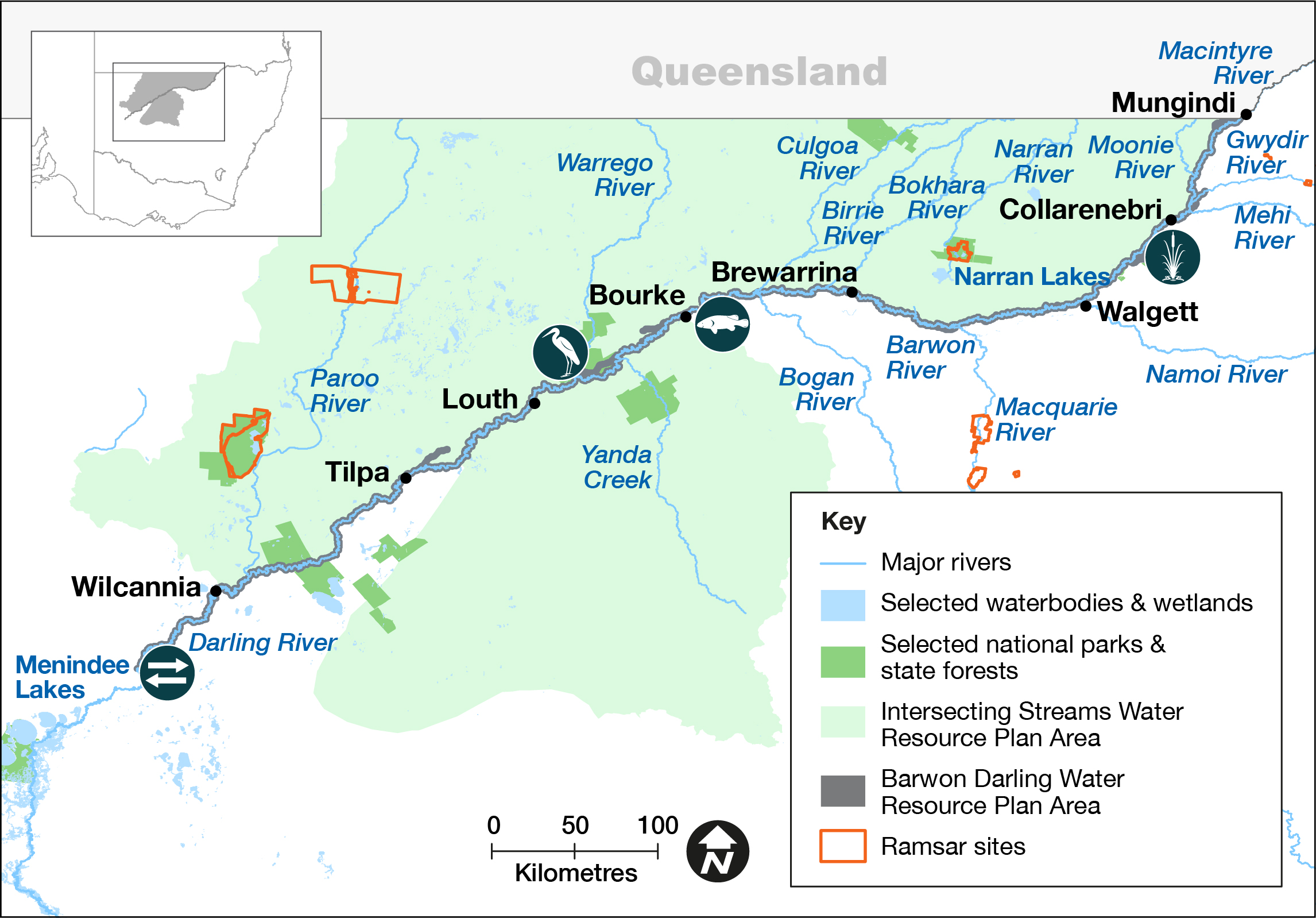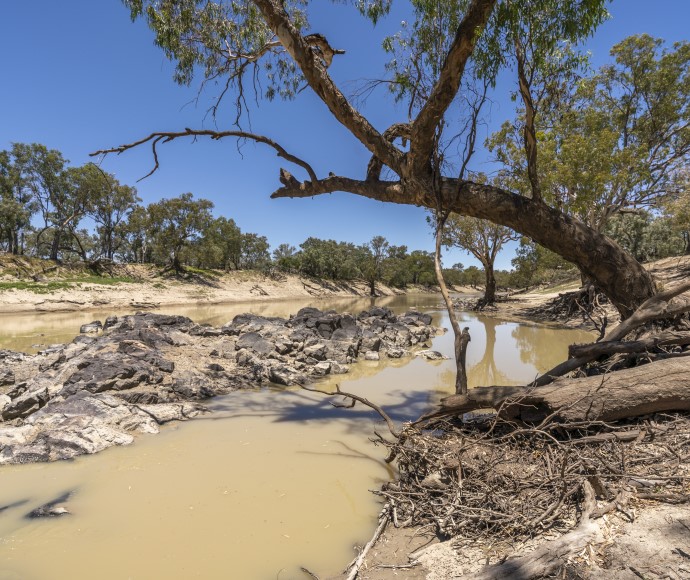The Barwon–Darling Barwaan–Baaka connects the river systems of the northern Murray–Darling Basin with those of the south.
Several major river systems flow into the Barwon-Darling Barwaan–Baaka including the Border, Moonie, Gwydir, Namoi, Macquarie, Wambuul, Culgoa and Paroo.
The Barwon–Darling Barwaan–Baaka rivers are the unregulated section of the river channel from the junction of the Macintyre and Weir rivers, near Mungindi, through to Lake Wetherell, part of the Menindee Lakes system. This includes distributary creeks and a myriad of floodplain wetlands, billabongs and streams.
The Barwon–Darling Barwaan–Baaka rivers and wetlands support important First Nations cultural values for the Euahlayi, Barkindji, Murrawarri, Ngemba, Gomeroi and Ngiyampaa people.
Water for rivers and wetlands
The Barwon–Darling Barwaan–Baaka rivers rely on rainfall and inflows from tributaries to support river health. Many of the tributaries which flow into the system are regulated by dams, weirs and floodplain structures. This influences the ability of water managers to actively plan events to enhance river and wetland outcomes in this system.
Extended periods of cease-to-flow dominated the flow regime of the river system during the period 2016 to 21. In summer 2020–21, the river benefited from flows from both Queensland and NSW tributaries. Since then, stable small fresh flows along with multiple large fresh and two overbank events have made up the flow regime.
These events have come from a range of sources, with the Border, Gwydir and Namoi providing the most substantial contributions. The Macquarie has sustained connection through much of this period. Significant rains have replenished major headwater storages with several dam spills occurring. With further flows in the Barwon–Darling Barwaan–Baaka system, opportunities may arise for use of held environmental water.
Weather and water forecast
The El Niño–Southern Oscillation (ENSO) outlook remains at La Nina, with a return to neutral ENSO during winter. Rainfall was above average and temperatures warmer than average in May and June 2022 for eastern mainland Australia, including the Barwon–Darling Barwaan–Baaka catchment, and this will continue in July.
Natural inflows are likely to continue in the Barwon–Darling Barwaan–Baaka, allowing water managers to use licensed water in various locations along the system if needed.
Water managers have prepared annual watering plans that consider a range of weather and water availability scenarios. On balance, the outlook is rated as ‘wet to very wet’.
Resource availability scenario
Forecast: Wet to very wet
| Conditions | Main aim | Other aims |
|---|---|---|
| Very dry | Protect | Avoid critical loss Maintain key refuges Avoid catastrophic events |
| Dry | Maintain | Maintain river functioning Maintain key functions of high priority wetlands |
| Moderate | Recover | Improve ecological health and resilience Improve opportunities for plants and animals to breed, move and thrive |
| Wet to very wet | Enhance | Restore key floodplain and wetland linkages Enhance opportunities for plants and animals to breed, move and thrive |
Key planned actions for 2022–23
Waterbirds
Colonial waterbird breeding is not expected without significant overbank flows occurring in spring and summer. With a continuation of current wet conditions, there is potential for this to occur. The diversity of waterbirds in riparian areas is expected to continue to improve, with abundance varying depending on conditions in the whole northern basin.
Native fish
As fish populations are still recovering from significant fish kills in the northern basin, a key priority is to support remaining stocks of native fish and provide opportunities for them to breed and disperse along the system. A key goal is to maintain flows and support small and large fresh events to help supply food to native fish and other aquatic wildlife including frogs.
Vegetation
Flows in 2021–22 have provided enough water to maintain existing riparian river red gum areas if dry conditions return. Large freshes or overbank flows are needed for useful watering for other floodplain vegetation. These flows rely on large inflows from tributary systems.
Connectivity
Considering the current conditions, it is unlikely cease-to-flow periods will return in 2022–23. Therefore, the focus moves to lateral connectivity to floodplains and anabranches with a possibility of further large freshes and overbank flows. Under more moderate rainfall conditions, small freshes and more consistent base flows are likely. An ongoing priority is maintaining connection between the Barwon–Darling Barwaan–Baaka River and the Lower Darling Baaka to support the recovery of native fish populations. Maintaining connection along the length of the river will require continued wet or moderate conditions across the northern basin.
Map of proposed annual priority targets in the water resource plan area 2022–23

Map of the Barwon-Darling catchment area showing priority targets for environmental water to be delivered to in 2022–23.
Watering actions cannot be planned in the Barwon-Darling Barwaan–Baaka rivers in the same way water for the environment can be managed in a regulated catchment. Environmental outcomes are typically generated by using licences to reduce the volume of water taken from flow events and to connect smaller flows to the system from regulated catchments.
The NSW Government works with the Commonwealth Environmental Water Holder to manage water in the catchment.
Currently, there is no Environmental Water Advisory Group in the Barwon-Darling Barwaan–Baaka system, so decisions are made by the Department of Climate Change, Energy, the Environment and Water in partnership with the Commonwealth Environmental Water Holder.
Water for the environment is a share of the water in dams and rivers that is set aside to support the long-term health of local rivers, creeks and wetlands. Healthy rivers carry water to homes, farms, schools and businesses. Rivers and wetlands are important cultural and spiritual sites for Aboriginal people, as well as the broader community.
Water licenced to the Commonwealth
| Source | Maximum volume available (megalitres) | Volume expected 1 July under current conditions (megalitres) |
|---|---|---|
| A class unregulated | 73 | Event-dependent |
| B class unregulated | 16,060 | Event-dependent |
| C class unregulated | 12,498 | Event-dependent |
Water licenced to New South Wales
| Source | Maximum volume available (megalitres) | Volume expected 1 July under current conditions (megalitres) |
|---|---|---|
| A class unregulated | 191 | Event-dependent |
| B class unregulated | 51 | Event-dependent |
| Unregulated | 1,488 | Event-dependent |
Notes: This is an indicative summary of expected volumes to be available. For further detail and information on available volumes you can contact the region via the Department of Climate Change, Energy, the Environment and Water on 1300 361 967.
1 gigalitre = 1000 megalitres; 2.5 megalitre = 1 Olympic swimming pool.

A gum tree arches over the Barwon-Darling watercourse
More information on planned and past watering events
- Barwon–Darling Rivers – Water for the Environment: Annual Priorities 2021–22
- Barwon-Darling rivers: Annual environmental watering priorities 2020–21
- Barwon Darling: Annual environmental watering priorities 2019–20
- Water for environment outcomes 2022–23
- Water for environment outcomes 2021–22
- Use of water for the environment in NSW: Outcomes 2020–21
- Use of water for the environment in NSW: Outcomes 2019–20
- Use of water for the environment in NSW: Outcomes 2018–19